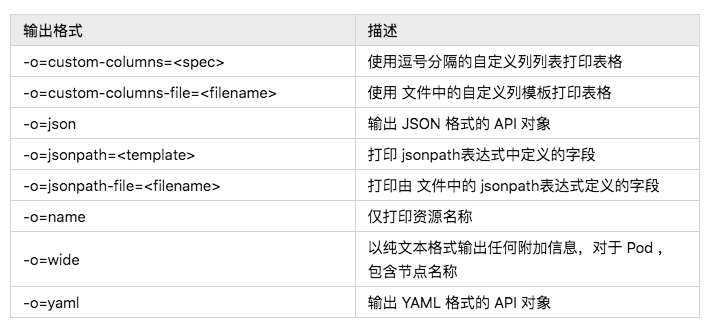
kubectl 常用命令指南
Kubectl 命令是操作 kubernetes 集群的最直接的方式,特别是运维人员,需要对这些命令有一个详细的掌握
Kubectl 自动补全
# setup autocomplete in bash, bash-completion package should be installed first.$ source <(kubectl completion bash)# setup autocomplete in zsh$ source <(kubectl completion zsh)
Kubectl 上下文和配置
# 显示合并后的 kubeconfig 配置$ kubectl config view# 同时使用多个 kubeconfig 文件并查看合并后的配置$ KUBECONFIG=~/.kube/config:~/.kube/kubconfig2 kubectl config view# 获取 e2e 用户的密码$ kubectl config view -o jsonpath='{.users[?(@.name == "e2e")].user.password}'# 显示当前的上下文$ kubectl config current-context# 设置默认上下文为 my-cluster-name$ kubectl config use-context my-cluster-name# 向 kubeconf 中增加支持基本认证的新集群$ kubectl config set-credentials kubeuser/foo.kubernetes.com --username=kubeuser --password=kubepassword# 使用指定的用户名和 namespace 设置上下文$ kubectl config set-context gce --user=cluster-admin --namespace=foo \&& kubectl config use-context gce
创建对象
.yaml、.yml、或者 .json 为扩展名。# 创建资源$ kubectl create -f ./my-manifest.yaml# 使用多个文件创建资源$ kubectl create -f ./my1.yaml -f ./my2.yaml# 使用目录下的所有清单文件来创建资源$ kubectl create -f ./dir# 使用 url 来创建资源$ kubectl create -f https://git.io/vPieo# 启动一个 nginx 实例$ kubectl run nginx --image=nginx# 获取 pod 和 svc 的文档$ kubectl explain pods,svc# 从 stdin 输入中创建多个 YAML 对象$ cat <<EOF | kubectl create -f -apiVersion: v1kind: Podmetadata:name: busybox-sleepspec:containers:- name: busyboximage: busyboxargs:- sleep- "1000000"---apiVersion: v1kind: Podmetadata:name: busybox-sleep-lessspec:containers:- name: busyboximage: busyboxargs:- sleep- "1000"EOF# 创建包含几个 key 的 Secret$ cat <<EOF | kubectl create -f -apiVersion: v1kind: Secretmetadata:name: mysecrettype: Opaquedata:password: $(echo "s33msi4" | base64)username: $(echo "jane" | base64)EOF
显示和查找资源
# Get commands with basic output# 列出所有 namespace 中的所有 service$ kubectl get services# 列出所有 namespace 中的所有 pod$ kubectl get pods --all-namespaces# 列出所有 pod 并显示详细信息$ kubectl get pods -o wide# 列出指定 deployment$ kubectl get deployment my-dep# 列出该 namespace 中的所有 pod 包括未初始化的$ kubectl get pods --include-uninitialized# 使用详细输出来描述命令$ kubectl describe nodes my-node$ kubectl describe pods my-pod# List Services Sorted by Name$ kubectl get services --sort-by=.metadata.name# 根据重启次数排序列出 pod$ kubectl get pods --sort-by='.status.containerStatuses[0].restartCount'# 获取所有具有 app=cassandra 的 pod 中的 version 标签$ kubectl get pods --selector=app=cassandra rc -o \jsonpath='{.items[*].metadata.labels.version}'# 获取所有节点的 ExternalIP$ kubectl get nodes -o jsonpath='{.items[*].status.addresses[?(@.type=="ExternalIP")].address}'# 列出属于某个 PC 的 Pod 的名字# “jq”命令用于转换复杂的 jsonpath,参考 https://stedolan.github.io/jq/$ sel=${$(kubectl get rc my-rc --output=json | jq -j '.spec.selector | to_entries | .[] | "\(.key)=\(.value),"')%?}$ echo $(kubectl get pods --selector=$sel --output=jsonpath={.items..metadata.name})# 查看哪些节点已就绪$ JSONPATH='{range .items[*]}{@.metadata.name}:{range @.status.conditions[*]}{@.type}={@.status};{end}{end}' \&& kubectl get nodes -o jsonpath="$JSONPATH" | grep "Ready=True"# 列出当前 Pod 中使用的 Secret$ kubectl get pods -o json | jq '.items[].spec.containers[].env[]?.valueFrom.secretKeyRef.name' | grep -v null | sort | uniq
更新资源
$ kubectl rolling-update frontend-v1 -f frontend-v2.json # 滚动更新 pod frontend-v1$ kubectl rolling-update frontend-v1 frontend-v2 --image=image:v2 # 更新资源名称并更新镜像$ kubectl rolling-update frontend --image=image:v2 # 更新 frontend pod 中的镜像$ kubectl rolling-update frontend-v1 frontend-v2 --rollback # 退出已存在的进行中的滚动更新$ cat pod.json | kubectl replace -f - # 基于 stdin 输入的 JSON 替换 pod# 强制替换,删除后重新创建资源。会导致服务中断。$ kubectl replace --force -f ./pod.json# 为 nginx RC 创建服务,启用本地 80 端口连接到容器上的 8000 端口$ kubectl expose rc nginx --port=80 --target-port=8000# 更新单容器 pod 的镜像版本(tag)到 v4$ kubectl get pod mypod -o yaml | sed 's/\(image: myimage\):.*$/\1:v4/' | kubectl replace -f -# 添加标签$ kubectl label pods my-pod new-label=awesome# 添加注解$ kubectl annotate pods my-pod icon-url=http://goo.gl/XXBTWq# 自动扩展 deployment “foo”$ kubectl autoscale deployment foo --min=2 --max=10
修补资源
使用策略合并补丁并修补资源。
# 部分更新节点kubectl patch node k8s-node-1 -p '{"spec":{"unschedulable":true}}'# 更新容器镜像;spec.containers[*].name 是必须的,因为这是合并的关键字$ kubectl patch pod valid-pod -p '{"spec":{"containers":[{"name":"kubernetes-serve-hostname","image":"new image"}]}}'# 使用具有位置数组的 json 补丁更新容器镜像$ kubectl patch pod valid-pod --type='json' -p='[{"op": "replace", "path": "/spec/containers/0/image", "value":"new image"}]'# 使用具有位置数组的 json 补丁禁用 deployment 的 livenessProbe$ kubectl patch deployment valid-deployment --type json -p='[{"op": "remove", "path": "/spec/template/spec/containers/0/livenessProbe"}]'
编辑资源
在编辑器中编辑任何 API 资源。
# 编辑名为 docker-registry 的 service$ kubectl edit svc/docker-registry# 使用其它编辑器$ KUBE_EDITOR="nano" kubectl edit svc/docker-registry
Scale 资源
# Scale a replicaset named 'foo' to 3$ kubectl scale --replicas=3 rs/foo# Scale a resource specified in "foo.yaml" to 3$ kubectl scale --replicas=3 -f foo.yaml# If the deployment named mysql's current size is 2, scale mysql to 3$ kubectl scale --current-replicas=2 --replicas=3 deployment/mysql# Scale multiple replication controllers$ kubectl scale --replicas=5 rc/foo rc/bar rc/baz
删除资源
# 删除 pod.json 文件中定义的类型和名称的 pod$ kubectl delete -f ./pod.json# 删除名为“baz”的 pod 和名为“foo”的 service$ kubectl delete pod,service baz foo# 删除具有 name=myLabel 标签的 pod 和 serivce$ kubectl delete pods,services -l name=myLabel# 删除具有 name=myLabel 标签的 pod 和 service,包括尚未初始化的$ kubectl delete pods,services -l name=myLabel --include-uninitialized# 删除 my-ns namespace 下的所有 pod 和 serivce包$ kubectl -n my-ns delete po,svc --all
与运行中的 Pod 交互
# dump 输出 pod 的日志(stdout)$ kubectl logs my-pod# dump 输出 pod 中容器的日志(stdout,pod 中有多个容器的情况下使用)$ kubectl logs my-pod -c my-container# 流式输出 pod 的日志(stdout)$ kubectl logs -f my-pod# 流式输出 pod 中容器的日志(stdout,pod 中有多个容器的情况下使用)$ kubectl logs -f my-pod -c my-container# 交互式 shell 的方式运行 pod$ kubectl run -i --tty busybox --image=busybox -- sh# 连接到运行中的容器$ kubectl attach my-pod -i# 转发 pod 中的 6000 端口到本地的 5000 端口$ kubectl port-forward my-pod 5000:6000# 在已存在的容器中执行命令(只有一个容器的情况下)$ kubectl exec my-pod -- ls /# 在已存在的容器中执行命令(pod 中有多个容器的情况下)$ kubectl exec my-pod -c my-container -- ls /# 显示指定 pod 和容器的指标度量$ kubectl top pod POD_NAME --containers
与节点和集群交互
# 标记 my-node 不可调度$ kubectl cordon my-node# 清空 my-node 以待维护$ kubectl drain my-node# 标记 my-node 可调度$ kubectl uncordon my-node# 显示 my-node 的指标度量$ kubectl top node my-node$ kubectl cluster-info# 将当前集群状态输出到 stdout$ kubectl cluster-info dump# 将当前集群状态输出到 /path/to/cluster-state$ kubectl cluster-info dump --output-directory=/path/to/cluster-state# 如果该键和影响的污点(taint)已存在,则使用指定的值替换$ kubectl taint nodes foo dedicated=special-user:NoSchedule
set 命令
kubectl set --help查看,它的子命令,env,image,resources,selector,serviceaccount,subject。kubectl set resources 命令
可用资源对象包括(支持大小写):replicationcontroller、deployment、daemonset、job、replicaset。
例如:
# 将deployment的nginx容器cpu限制为“200m”,将内存设置为“512Mi”$ kubectl set resources deployment nginx -c=nginx --limits=cpu=200m,memory=512Mi# 设置所有nginx容器中 Requests和Limits$ kubectl set resources deployment nginx --limits=cpu=200m,memory=512Mi --requests=cpu=100m,memory=256Mi# 删除nginx中容器的计算资源值$ kubectl set resources deployment nginx --limits=cpu=0,memory=0 --requests=cpu=0,memory=0
kubectl set selector 命令
selector(选择器)。如果在调用”set selector”命令之前已经存在选择器,则新创建的选择器将覆盖原来的选择器。selector必须以字母或数字开头,最多包含63个字符,可使用:字母、数字、连字符” - “ 、点”.”和下划线” _ “。如果指定了—resource-version,则更新将使用此资源版本,否则将使用现有的资源版本。语法:selector (-f FILENAME | TYPE NAME) EXPRESSIONS [—resource-version=version]
kubectl set image 命令
用于更新现有资源的容器镜像。
可用资源对象包括:pod (po)、replicationcontroller (rc)、deployment (deploy)、daemonset (ds)、job、replicaset (rs)。
语法:image (-f FILENAME | TYPE NAME) CONTAINER_NAME_1=CONTAINER_IMAGE_1 … CONTAINER_NAME_N=CONTAINER_IMAGE_N
# 将deployment中的nginx容器镜像设置为“nginx:1.9.1”$ kubectl set image deployment/nginx busybox=busybox nginx=nginx:1.9.1# 所有deployment和rc的nginx容器镜像更新为“nginx:1.9.1”$ kubectl set image deployments,rc nginx=nginx:1.9.1 --all# 将daemonset abc的所有容器镜像更新为“nginx:1.9.1”$ kubectl set image daemonset abc *=nginx:1.9.1# 从本地文件中更新nginx容器镜像$ kubectl set image -f path/to/file.yaml nginx=nginx:1.9.1 --local -o yaml
资源类型
格式化输出
kubectl 命令中添加 -o 或者 -output 标志。-v 或 --v 标志跟着一个整数来指定日志级别。注:如有侵权请联系删除
热文推荐
欢迎关注LemonSec
觉得不错点个“赞”、“在看”
文章来源: http://mp.weixin.qq.com/s?__biz=MzUyMTA0MjQ4NA==&mid=2247532104&idx=3&sn=4a2429a0a3a3fc5b6333ed3d5efca96f&chksm=f9e31113ce9498051e94985ba65aae861e9484f2764a1e9b0d3b9ed73c46a19925ac4d1ec694#rd
如有侵权请联系:admin#unsafe.sh
如有侵权请联系:admin#unsafe.sh